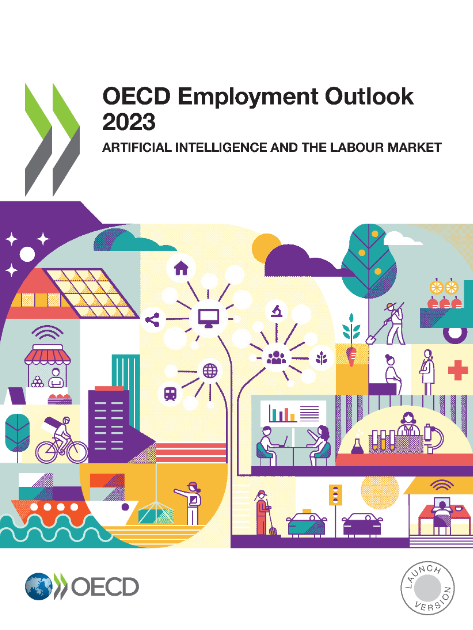
□ 보고서는 AI의 확산은 법률이나 의학, 회계 등 전문직 분야 실업을 유발할 수 있다고 경고하면서, AI가 몰고 올 자동화로 인해 가장 큰 위협을 받는 고숙련 직업은 38개 회원국 고용의 27%를 차지한다고 분석함. 또한, 'AI가 사람을 대체할 가능성이 있다는 것은 명확하다'라며 '이는 임금 감소와 실업에 대한 공포를 키우게 될 것'이라고 전망함. 다만, 당분간 AI는 직업을 변화시킬 뿐, 대체하지는 않을 것이라고 언급함
□ 최근 AI 기술이 빠르게 발전하면서 생성형 AI인 챗GPT 등의 경우 이들이 생산하는 콘텐츠가 사람의 것과 거의 구분이 되지 않는 수준에 이르렀으며, 이에 주요 경제국들은 '티핑 포인트*'에 와 있다고 OECD는 분석함. 또한, 'AI 기술의 빠른 발전과 그로 인한 관련 기술 도입 비용 감소로 인해 OECD 회원국들은 노동 현장을 근본적으로 바꾸게 될 AI 혁명기로 들어가는 길목에 서 있다'고 진단함
*급격한 변화 시점
□ OECD는 기업들은 AI에 투자하는 주요 동기가 직원의 성과를 높이고 고용 비용을 줄이는 것이며, 결과적으로 고급 교육이 필요한 고소득 직업이 가장 큰 어려움을 겪을 수 있다고 주장함. 이와 함께 AI가 직장에서 부적절한 영향력을 행사하는 것을 경계해야 한다고 제시함. 일례로 채용에 AI를 활용할 경우 AI가 특정 인종에 대해 차별적인 판단을 하는 등 오류를 일으킬 수 있다며, OECD는 각국이 AI가 직장에서 적절히, 신뢰성 있게 쓰일 수 있도록 관련 방안을 시급히 마련해야 한다고 조언함
(출처: 연합뉴스)
목차
Foreword 3
Editorial : Beyond the hype on Al - early signs of divides in the labour market 4
Executive summary 13
1 Under pressure : Labour market and wage developments in OECD countries 16
In Brief 17
Introduction 19
1.1. As economic growth lost momentum in 2022, labour market indicators across the OECD stabilised 20
1.2. Inflation reached levels not seen in decades, causing real wages to fall across the OECD 32
1.3. Wage setting in a high inflation environment 46
1.4. Concluding remarks 61
References 68
Annex 1. A. Additional results 71
Annex 1. B. Identifying employee benefits in online job postings 71
Annex 1. C. Latest developments on minimum wages and negotiated wages 74
Notes 88
2 Artificial intelligence and the labour market : Introduction 93
We need to talk about the future of work ( again... ) 94
For better or for worse, Al is already making its way into the workplace 95
The time to act is now 96
References 98
Notes 100
3 Artificial intelligence and jobs : No signs of slowing labour demand ( yet ) 102
In Brief 103
Introduction 104
3.1.Artif icial intelligence expands the set of jobs at risk of automation 105
3.2. It is too early to detect meaningful employment changes due to artificial intelligence 111
3.3. Policy can promote Al use that complements human labour and broadly shared productivity gains 118
References 119
Notes 124
4 Artificial intelligence, job quality and inclusiveness 128
In Brief 129
Introduction 130
4.1. Workers with AI skills earn significant wage premiums, but it is too soon to see AI’s effects on labour productivity 131
4.2. Using AI is associated with higher job satisfaction and occupational safety, but there are some risks 137
4.3. AI-led reorganisation or automation of managers’ tasks has downstream effects on their subordinates 140
4.4. The impact of AI on inclusiveness and bias in the labour market 144
4.5. Concluding remarks 147
References 148
Notes 153
5 Skill needs and policies in the age of artificial intelligence 155
In Brief 156
Introduction 157
5.1. The development and adoption of AI will have an impact on skill needs 157
5.2. Changes in skill needs call for new training opportunities 163
5.3. Firms implementing AI say they provide training to their employees, but more training may be necessary 167
5.4. Existing public policies supporting training for AI are not sufficient 169
5.5. AI has the potential to improve adult learning systems but risks exist 172
5.6. Despite a growing body of research on AI and its impact on skills and learning systems, important knowledge gaps persist 175
References 176
Notes 179
6 Ensuring trustworthy artificial intelligence in the workplace: Countries’ policy action 182
In Brief 183
Introduction 185
6.1. Soft law for trustworthy AI in the workplace 188
6.2. Legislation for trustworthy AI in the workplace 190
6.3. Concluding remarks 203
References 205
Notes 217
7 Social dialogue and collective bargaining in the age of artificial intelligence 221
In Brief 222
Introduction 223
7.1. AI transition: What is different for social dialogue? 224
7.2. Shaping the AI transition: The role of social dialogue 228
7.3. Social partners are engaging in outreach, awareness raising and advocacy 233
7.4. Promoting social partners’ expertise to shape the AI transition 238
7.5. Concluding remarks 239
References 240
Annex 7.A. OECD Questionnaire on AI impact and social dialogue 247
Annex 7.B. Supplementary materials 251
Notes 254
Annex A. Statistical annex 257
해시태그
관련자료
AI 100자 요약·번역서비스
인공지능이 자동으로 요약·번역한 내용입니다.
OECD Employment Outlook 2023 : Artificial Intelligence and the Labour Market
(OECD 고용 전망 2023 : 인공지능과 노동시장)


